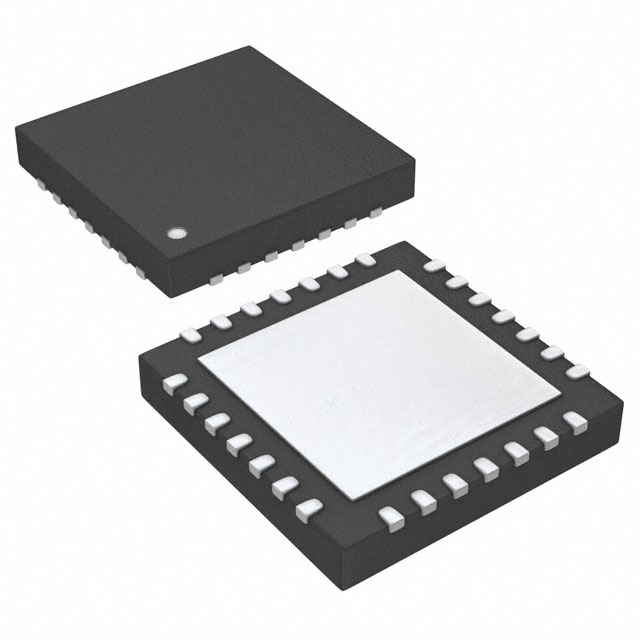Lihat spesifikasi untuk detail produk.

PIC16F87-E/ML
Product Overview
Category
The PIC16F87-E/ML belongs to the category of microcontrollers.
Use
This microcontroller is commonly used in various electronic devices and systems for controlling and processing data.
Characteristics
- High-performance 8-bit RISC architecture
- Wide operating voltage range
- Low power consumption
- Enhanced flash program memory
- Integrated peripherals for versatile applications
Package
The PIC16F87-E/ML is available in a small form factor package, specifically the ML (Micro Leadframe) package.
Essence
The essence of the PIC16F87-E/ML lies in its ability to provide efficient control and processing capabilities in a compact and low-power package.
Packaging/Quantity
The PIC16F87-E/ML is typically packaged in reels or tubes, with a quantity of 1000 units per package.
Specifications
- Architecture: 8-bit RISC
- Program Memory Size: 8 KB
- RAM Size: 368 bytes
- Operating Voltage Range: 2.0V to 5.5V
- Maximum CPU Speed: 20 MHz
- Number of I/O Pins: 33
- Timers: 3
- Analog-to-Digital Converter (ADC): 8 channels, 10-bit resolution
- Serial Communication: USART, SPI, I2C
Detailed Pin Configuration
The PIC16F87-E/ML features a total of 40 pins, each serving a specific purpose. The pin configuration is as follows:
- VDD - Power supply voltage
- RA0 - General-purpose I/O pin
- RA1 - General-purpose I/O pin
- RA2 - General-purpose I/O pin
- RA3 - General-purpose I/O pin
- RA4 - General-purpose I/O pin
- RA5 - General-purpose I/O pin
- MCLR/VPP - Master Clear input or programming voltage
- VSS - Ground
- RB0/INT - General-purpose I/O pin or external interrupt input
- RB1 - General-purpose I/O pin
- RB2 - General-purpose I/O pin
- RB3 - General-purpose I/O pin
- RB4 - General-purpose I/O pin
- RB5 - General-purpose I/O pin
- RB6 - General-purpose I/O pin
- RB7 - General-purpose I/O pin
- VDD - Power supply voltage
- OSC1/CLKIN - Oscillator input
- OSC2/CLKOUT - Oscillator output
- RC0 - General-purpose I/O pin
- RC1 - General-purpose I/O pin
- RC2 - General-purpose I/O pin
- RC3 - General-purpose I/O pin
- RC4 - General-purpose I/O pin
- RC5 - General-purpose I/O pin
- RC6/TX/CK - General-purpose I/O pin or USART transmit or synchronous clock output
- RC7/RX/DT - General-purpose I/O pin or USART receive or asynchronous data transmit
Functional Features
The PIC16F87-E/ML offers several functional features that enhance its usability and performance:
- Enhanced Flash Program Memory: The microcontroller has a larger program memory size, allowing for more complex code storage.
- Integrated Peripherals: It includes built-in peripherals such as timers, ADC, and serial communication modules, reducing the need for external components.
- Low Power Consumption: The microcontroller is designed to operate efficiently with minimal power consumption, making it suitable for battery-powered applications.
- Wide Operating Voltage Range: The PIC16F87-E/ML can operate within a wide voltage range, providing flexibility in various applications.
Advantages and Disadvantages
Advantages
- High-performance RISC architecture for efficient processing
- Integrated peripherals reduce external component count
- Low power consumption extends battery life
- Wide operating voltage range allows for versatile applications
Disadvantages
- Limited program memory size compared to higher-end microcontrollers
- Limited RAM size may restrict complex data processing capabilities
Working Principles
The PIC16F87-E/ML operates based on the principles of an 8-bit RISC architecture. It executes instructions stored in its program memory, processes data using its integrated peripherals, and communicates with external devices through its I/O pins. The microcontroller follows a sequential execution model, where each instruction is fetched, decoded, and executed in a step-by-step manner.
Detailed Application Field Plans
The PIC16F87-E/ML finds applications in various fields, including but not limited to:
- Home Automation: Controlling and monitoring household appliances and systems.
- Industrial Control Systems: Managing and regulating industrial processes and machinery.
- Automotive Electronics:
Sebutkan 10 pertanyaan dan jawaban umum terkait penerapan PIC16F87-E/ML dalam solusi teknis
What is the maximum operating frequency of PIC16F87-E/ML?
- The maximum operating frequency of PIC16F87-E/ML is 20 MHz.How many I/O pins does PIC16F87-E/ML have?
- PIC16F87-E/ML has a total of 33 I/O pins.What is the flash program memory size of PIC16F87-E/ML?
- The flash program memory size of PIC16F87-E/ML is 7 KB.Can PIC16F87-E/ML be used for analog-to-digital conversion?
- Yes, PIC16F87-E/ML features an integrated 8-channel 10-bit ADC.What communication interfaces are supported by PIC16F87-E/ML?
- PIC16F87-E/ML supports USART, SPI, and I2C communication interfaces.Is PIC16F87-E/ML suitable for battery-powered applications?
- Yes, PIC16F87-E/ML offers low power consumption, making it suitable for battery-powered applications.What development tools are available for programming PIC16F87-E/ML?
- Development tools such as MPLAB X IDE and PICkit programmers can be used to program PIC16F87-E/ML.Can PIC16F87-E/ML be used in automotive applications?
- Yes, PIC16F87-E/ML is suitable for automotive applications due to its wide operating voltage range and robust design.Does PIC16F87-E/ML have built-in timers and PWM modules?
- Yes, PIC16F87-E/ML features multiple timers and PWM modules for precise timing and control.What are the typical applications of PIC16F87-E/ML?
- Typical applications of PIC16F87-E/ML include industrial control systems, consumer electronics, and embedded control applications.

